Callimachus
Stubby hooksquid
K.S.R. Bolstad, Richard E. Young, and Michael Vecchione- Callimachus rancureli
- Callimachus youngorum
Introduction
Callimachus species are small, muscular squids that appear to be common but are rarely captured by trawls. The maximum adult size recorded is a female of ML 150 mm (C. rancureli), and males have been observed to mature at ML ~80 mm. This genus is easily recognized by its short, broad shape and oval fins.
The type locality of the type species, C. rancureli the tropical Indian Ocean, but additional Callimachus specimens are known from the tropical North and South Pacific and from the tropical and south temperate Atlantic. Separation of species is difficult and there is some indication that more than the three presently recognized species may exist (Bolstad, 2010).
Diagnosis
An onychoteuthid with...
- oval fins, not drawn-out posteriorly (unique character within family).
- elongate-rhombic shaped vanes and short, blunt rostrum oriented perpendicular to tip of gladius (unique character within family).
- gladius visible beneath skin in dorsal midline.
- Primary occipital folds only.
Characteristics
- Arms
- Dorsal protective membranes of arms II and III greatly enlarged (ca. 2X) relative to their ventral protective membranes, and with long, well-defined trabeculae.
- Dorsal protective membranes of arms II and III greatly enlarged (ca. 2X) relative to their ventral protective membranes, and with long, well-defined trabeculae.
- Tentacular club
- A few marginal suckers present in subadults.
- Occipital region
- 3 primary occipital folds; large occipital membrane from fold 3 extends dorsally and curves to join occipital crest without forming a distinct fourth fold. Olfactory organ lies at posterior end of fold no. 2.No secondary occipital folds present.
- 3 primary occipital folds; large occipital membrane from fold 3 extends dorsally and curves to join occipital crest without forming a distinct fourth fold. Olfactory organ lies at posterior end of fold no. 2.No secondary occipital folds present.
- Head
- Beaks: Descriptions can be found here: Lower beak; upper beak.
- Beaks: Descriptions can be found here: Lower beak; upper beak.
- Mantle
- The dorsal ridge of the gladius is readily visible dorsally on an intact squid.
-
 Click on an image to view larger version & data in a new window
Click on an image to view larger version & data in a new window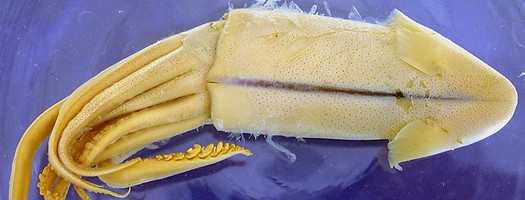
Figure. Dorsal view of the holotype of Callimachus rancureli showing the muscles of the mantle to not join one another in the midline but fuse to the gladius (via the shell sac) making the gladius visible through the dorsal integument (when chromatophores are contracted). Photograph by R. Young.
- The dorsal ridge of the gladius is readily visible dorsally on an intact squid.
- Fins
- Oval with large anterior lobes; not drawn-out posteriorly; apical fin-angle approximately 180°.
 Click on an image to view larger version & data in a new window
Click on an image to view larger version & data in a new window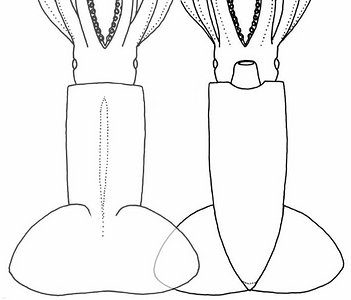

Figure. Dorsal and ventral views of two Callimachus rancureli from different localities to show the shape of the fins. Left - Eastern Indian Ocean, female, 105 mm ML). Drawing from Bolstad, 2010. Right - Off New Caledonia, female, 87 mm ML. Drawing from Rancurel, 1970.
- Oval with large anterior lobes; not drawn-out posteriorly; apical fin-angle approximately 180°.
- Photophores
- Absent.
- Absent.
- Gladius
- Short, blunt rostrum directed perpendicular to posterior end of gladius.
- Gladius with elongate-rhombic shaped vanes; vanes with a sharp lateral angle.
 Click on an image to view larger version & data in a new window
Click on an image to view larger version & data in a new window
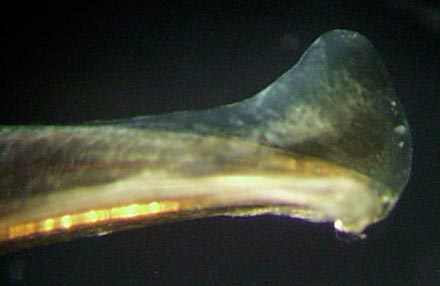
Figure. Left - Lateral view (top) and dorsal view (bottom) of the gladius of Callimachus rancureli. (off New Caledonia, 87 mm ML), with an enlarged insert of the gladius rostrum and conus. Drawings from Rancurel, 1970. Right - Side view of the posterior end of the gladius of C. youngorum (Hawaii, 37 mm M) showing the rostrum and small conus. Photograph by R. Young.
Nomenclature
There is disagreement about the generic placement of the species rancureli and youngorum. Okutani (1981) originally attributed his new species rancureli to Onykia, based on its overall external resemblance to juveniles of that genus (ovate to paddle-shaped fins, presence of marginal suckers on the tentacle club). However, its retention of these features into maturity, its small size, smooth skin and the unique elongate-rhombic gladius readily separate it from Onykia.Some authors believe C. rancureli to be a senior name for Walvisteuthis virilis Nesis & Nikitina, 1986, a species originally described in its own family, the Walvisteuthidae, based on a single mature male. This specimen, the holotype, was somewhat similar to onychoteuthids but it had a number of very peculiar features that caused the authors to erect the new family: enlarged distal suckers on Arms III, dentate suckers on all arms, and club morphology comprised solely of sparse, small, irregularly set suckers. Those who propose C. rancureli and W. virilis to be synonymous consider these peculiar features to be modifications that arise at sexual maturity, and since these differences would certainly require a separate genus from other known onychoteuthids, they suggest that Walvisteuthis is the appropriate generic name.
Bolstad (2010) considered these peculiar features too un-onychoteuthid-like to accept the synonymy, and erected the genus Callimachus for the species rancureli and youngorum, based on the following rationale: "Since W. virilis is known only from adult male specimens, while C. rancureli is known from subadult and spent females, and smaller individuals of both sexes, the morphological differences observed to date could conceivably represent sexual dimorphism. The unusual tentacle clubs on the W. virilis holotype may have been regenerating at the time of capture, since their overall appearance is similar to that of a regenerating club observed in Onykia robusta [Bolstad 2010, fig. 35D]. However, given that the characteristic onychoteuthid hooks are absent from the holotype of W. virilis, while several characters that would be unique within the Onychoteuthidae are present (the strongly enlarged distal suckers on Arms III, the dentate arm suckers), and that no material of W. virilis was available for examination in this study, Walvisteuthidae is retained as a separate family at present. The species rancureli and youngorum are certainly onychoteuthids, but cannot be accommodated within any existing onychoteuthid genus as presently recognised. They are therefore attributed to a new genus, Callimachus."Life History
Paralarvae of this genus are known as small as 1.9 mm ML. The smallest paralarvae are extremely slender with a mantle width about 25% of the ML. Between this size and about 4-5 mm ML (Fig. A) they are easily recognized by their slender appearance and a distinctive elongate patch of large chromatophores along the dorsal midline. The eyes are dorsoventrally elongate and strongly bulge from the head. Club suckers are in two series, large (about the same size as the arm suckers) and prominent. At roughly 4-5 mm ML (Fig. B) the paralarvae begin a strong morphological change. They start to become relative broad, the eyes become hemispherical and the fins become much more prominent. At 7 mm (Fig. C) the squid is very broad for its length. Chromatophores are small and scattered but larger on the dorsal surfaces than ventral surfaces. On the ventral surface of the head the chromatophores are deep within the tissue and not readily visible in preserved specimens. By 12 mm ML the V-shaped funnel groove and the distinctive rostrum are present and hooks are beginning to form in the medial-ventral series on the club.

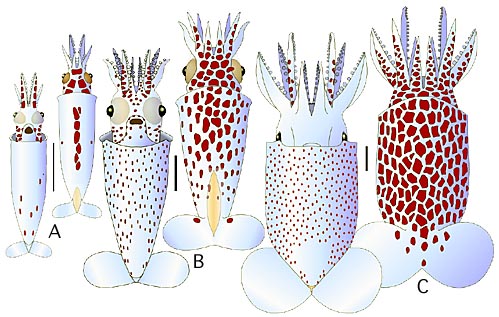
Figure. Ventral and dorsal views of growth stages of paralarvae of Callimachus youngorum., Hawaii. A - Small, slender-stage paralarva, 2.4 mm ML. B - Paralarva in transition between slender and squat-body forms, 4.5 mm ML. C - Squat-stage paralarva, 7.0 mm ML. The scale bar is 1 mm. Drawings by R. Young.
Other Names for Callimachus
- Onykia rancureli
- Walvisteuthis rancureli
- Walvisteuthis hawaiiensis
- Stubby hooksquid
- Walvisteuthis
References
Rancurel, P. 1970. Les contenus stomacaux d?Alepisaurus ferox dans le Sud-ouest Pacifique (cephalopodes). Cah. O.R.S.T.O.M., ser. Oceanogr., 8: 3-87.
Title Illustrations

| Scientific Name | Callimachus youngorum |
|---|---|
| Location | Hawaiian waters |
| Specimen Condition | Preserved |
| Sex | Male |
| View | dorsal and ventral |
| Size | 65 mm ML |
| Collection | SBMNH 149643 |
| Type | Holotype |
| Image Use |
 This media file is licensed under the Creative Commons Attribution-NonCommercial License - Version 3.0. This media file is licensed under the Creative Commons Attribution-NonCommercial License - Version 3.0.
|
| Copyright |
©

|
| Scientific Name | Callimachus youngorum |
|---|---|
| Location | Hawaiian waters |
| Identified By | K. Bolstad |
| Sex | Male |
| View | ventral |
| Size | 65 mm ML |
| Image Use |
 This media file is licensed under the Creative Commons Attribution-NonCommercial License - Version 3.0. This media file is licensed under the Creative Commons Attribution-NonCommercial License - Version 3.0.
|
| Copyright |
©

|
About This Page

EOS Research Institute, Auckland University of Technology, New Zealand

University of Hawaii, Honolulu, HI, USA

National Museum of Natural History, Washington, D. C. , USA
Correspondence regarding this page should be directed to K.S.R. Bolstad at
Page copyright © 2014 , , and
 Page: Tree of Life
Callimachus . Stubby hooksquid.
Authored by
K.S.R. Bolstad, Richard E. Young, and Michael Vecchione.
The TEXT of this page is licensed under the
Creative Commons Attribution License - Version 3.0. Note that images and other media
featured on this page are each governed by their own license, and they may or may not be available
for reuse. Click on an image or a media link to access the media data window, which provides the
relevant licensing information. For the general terms and conditions of ToL material reuse and
redistribution, please see the Tree of Life Copyright
Policies.
Page: Tree of Life
Callimachus . Stubby hooksquid.
Authored by
K.S.R. Bolstad, Richard E. Young, and Michael Vecchione.
The TEXT of this page is licensed under the
Creative Commons Attribution License - Version 3.0. Note that images and other media
featured on this page are each governed by their own license, and they may or may not be available
for reuse. Click on an image or a media link to access the media data window, which provides the
relevant licensing information. For the general terms and conditions of ToL material reuse and
redistribution, please see the Tree of Life Copyright
Policies.
- First online 23 June 2003
- Content changed 06 December 2014
Citing this page:
Bolstad, K.S.R., Richard E. Young, and Michael Vecchione. 2014. Callimachus . Stubby hooksquid. Version 06 December 2014 (under construction). http://tolweb.org/Callimachus/19957/2014.12.06 in The Tree of Life Web Project, http://tolweb.org/




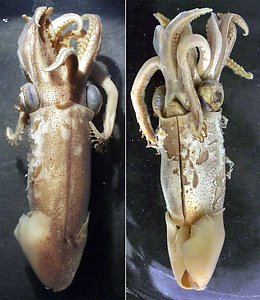





 Go to quick links
Go to quick search
Go to navigation for this section of the ToL site
Go to detailed links for the ToL site
Go to quick links
Go to quick search
Go to navigation for this section of the ToL site
Go to detailed links for the ToL site